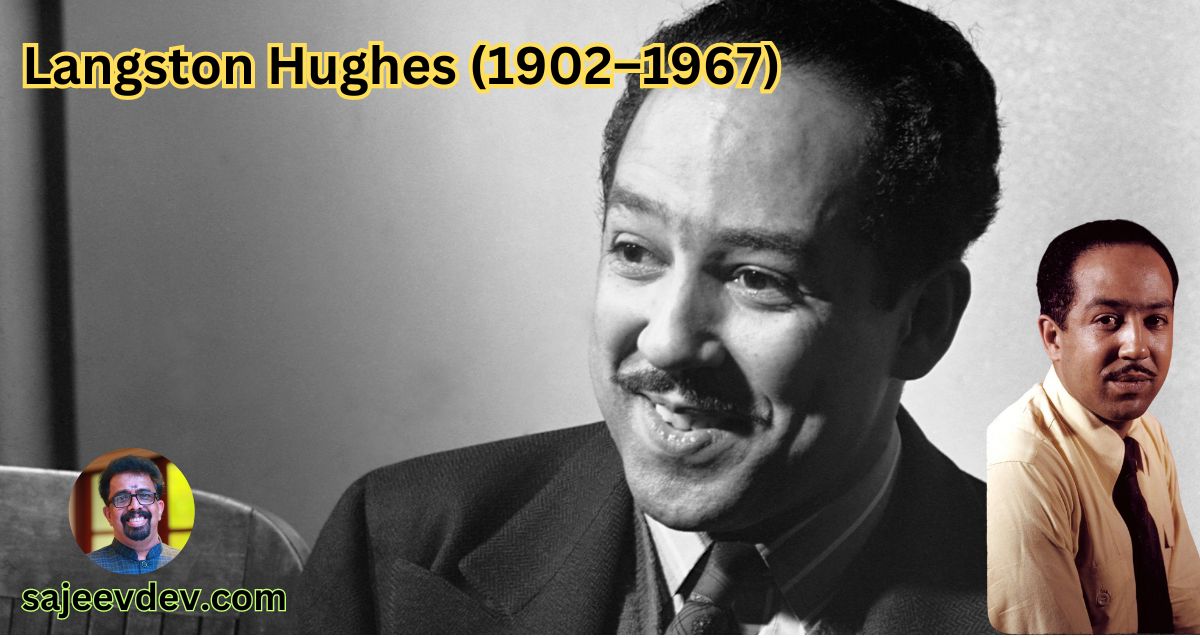Langston Hughes stands as a pivotal figure in American literature, particularly known for his contributions during the Harlem Renaissance, a cultural movement that blossomed in the early 20th century
Langston Hughes stands as a pivotal figure in American literature, particularly known for his contributions during the Harlem Renaissance, a cultural movement that blossomed in the early 20th century. Born on February 1, 1902, in Joplin, Missouri, Hughes grew up in a racially divided America, where he experienced both the beauty and the harsh realities of life as an African American. His upbringing, punctuated by his grandmother’s strong influence and exposure to various cultural experiences, provided a rich tapestry of inspiration that would later manifest in his poetry and prose.
Hughes’s literary career began to take shape in the 1920s, a period characterized by a surge of African American cultural expression that sought to redefine identity and acknowledge the complexities of race in America. The Harlem Renaissance fostered an environment where artists, musicians, and writers explored their heritage, and Hughes emerged as one of its most prominent voices. Through his art, he articulated the struggles, aspirations, and triumphs of the African American experience, resonating with diverse audiences both within the African American community and beyond.
As a poet, Hughes captivated readers with his unique ability to combine jazz rhythms and colloquial speech, effectively capturing the essence of African American life. His work was not only a reflection of his own experiences but also an exploration of collective history, addressing themes such as racial pride, social justice, and the quest for equality. Hughes’s influence extends far beyond his lifetime; his writings continue to inspire generations of poets, writers, and activists who seek to give voice to the marginalized and challenge societal norms. In this way, Hughes’s legacy as a literary giant remains integral to understanding the evolution of African American literature and its profound impact on American culture at large.
The Harlem Renaissance and Its Influence on Hughes
The Harlem Renaissance was a vibrant cultural, social, and artistic movement that emerged in the early 20th century, primarily in the Harlem neighborhood of New York City. This period, spanning from the 1910s to the mid-1930s, saw a flourishing of African American art, literature, and intellectual thought, which played a crucial role in shaping the identity of African American culture. It served as a backdrop for the works of numerous artists and writers, among them the renowned poet, Langston Hughes.
At its core, the Harlem Renaissance aimed to reclaim and redefine the African American experience in the wake of pervasive racial discrimination and segregation. This movement sought to celebrate black culture through artistic expression and foster a sense of pride in African American heritage. Intellectuals such as W.E.B. Du Bois and Alain Locke championed the concept of the “New Negro,” advocating for a proactive and confident portrayal of black identity that countered existing stereotypes in mainstream society.
Hughes emerged as one of the most influential figures of the Harlem Renaissance, drawing inspiration from the cultural diversity and rich histories of African American communities. His poetry, infused with a distinct blend of jazz, blues, and folk elements, reflected the rhythm and richness of black life in America. By exploring themes of racial identity, social justice, and the beauty of everyday experiences, Hughes’s work resonated deeply with both African American and mainstream audiences.
The impact of the Harlem Renaissance extended far beyond its immediate artistic achievements. It laid the groundwork for future generations of African American writers and artists, establishing a legacy that continues to inspire creativity and cultural expression today. Through their contributions, Hughes and his contemporaries helped redefine American literature, setting the stage for a more inclusive narrative that embraced the complexities of African American culture.
Celebration of African American Culture and Heritage
Langston Hughes stands as a towering figure in American literature, primarily recognized for his profound contributions to the Harlem Renaissance. His poetry serves as a medium through which he celebrates African American culture and heritage, illuminating the rich traditions, struggles, and aspirations of black life in the United States. Central to Hughes’s work is his unwavering affirmation of African American identity, as he seeks to elevate the narratives and experiences often marginalized or overlooked in mainstream discourse.
One of the hallmark themes in Hughes’s poetry is the celebration of cultural pride. In pieces such as “The Weary Blues,” he captures the essence of African American music—a blend of rhythms and emotions that communicate both suffering and joy. Hughes not only embraces jazz and the blues as significant aspects of black culture but also integrates these musical forms into his poetic structure, thereby mirroring the authentic experience of the African American community. This artistic synergy not only reflects the sounds of a people but also symbolizes their resilience and emotional depth.
Moreover, Hughes’s works often depict communal life and the everyday experiences of African Americans, providing a window into the social dynamics of black communities. Poems like “Mother to Son” convey messages of perseverance and familial strength, illustrating the values deeply rooted in African American heritage. By focusing on the significance of family, community, and cultural customs, Hughes captures not only the struggles faced by African Americans but also their indomitable spirit and rich traditions.
Through celebrating African American culture and heritage, Langston Hughes ensures that the voices and experiences of his community resonate loudly, fostering a greater understanding of their histories and identities. His poetry remains a powerful testament to the beauty and complexity of black life, paving the way for future generations to honor and cherish their cultural legacy.
Jazz Rhythms in Hughes’s Poetry
Langston Hughes is often celebrated for his ability to weave the rich fabric of African American culture into his poetry. A significant aspect of his work is the influence of jazz and blues, musical genres deeply rooted in the African American experience. Hughes was not merely a poet but a keen observer of the rhythms of life around him, which he translated into his written words. His keen ear for the musicality of language allowed him to incorporate jazz rhythms and vernacular speech in a manner that mirrored the cadence and emotional depth of jazz music itself.
One of the most striking features of Hughes’s poetry is its musical structure. He frequently employed syncopation and varied line lengths, mimicking the improvisational quality found in jazz performances. This stylistic choice not only enhanced the auditory experience of his work but also served to capture the dynamic essence of the African American struggle and celebration of life. For instance, in poems like “The Weary Blues,” Hughes uses rhythmic variations that evoke the sounds of a jazz ensemble, enabling readers to feel the pulse of the music while engaging with the text.
Furthermore, Hughes’s use of vernacular speech granted authenticity to his characters and narratives. By employing the colloquial language of African Americans, he created a voice that resonated with the lived experiences of his community. This linguistic choice deepened the emotional resonance of his poems, allowing them to act as a bridge between the reader and the artist’s cultural heritage. Hughes’s ability to fuse the musical qualities of jazz with poetic form thus marked a significant evolution in American literature, illustrating how the arts can serve as a powerful medium for cultural expression and social commentary.
The Weary Blues: A Deep Dive
Langston Hughes’s poem “The Weary Blues” stands as a significant contribution to American literature, showcasing the intersection of music, emotion, and the African American experience. Written in 1925, this poem not only exemplifies Hughes’s mastery of the blues form but also serves as a poignant portrayal of the struggles faced by African Americans during the early 20th century. The poem’s structure blends rhythm and rhyme with a distinct musicality that highlights its deep cultural roots, allowing readers to experience the sorrow and joy intertwined in the black experience.
Thematically, “The Weary Blues” delves into the duality of hardship and resilience. The poem’s speaker encounters a blues musician, whose music conveys a profound sense of weariness yet simultaneously embodies a celebration of survival. Through the use of rich imagery and metaphors, Hughes captures the essence of the blues genre: a soulful expression that echoes both despair and hope. Lines such as the description of the musician’s “drowsy, deep, like a river” voice create an auditory experience that immerses readers in the emotional landscape of the poem.
Furthermore, the significance of “The Weary Blues” extends beyond its artistic merit. It embodies the broader cultural movement of the Harlem Renaissance, during which African American artists sought to affirm their identity and heritage through their work. Hughes’s ability to weave personal and collective narratives within this poem speaks to the resilience of the African American community amidst ongoing struggle. Through “The Weary Blues,” Hughes not only shares a story of weariness but also ignites a spark of hope, making it a timeless celebration of the African American spirit.
Hughes’s Use of Vernacular Speech
Langston Hughes is renowned for his masterful incorporation of vernacular speech in his poetry, a stylistic choice that profoundly reflects the experiences and cultural expressions of African Americans. By embracing the natural rhythms and phonetics of everyday language, Hughes not only captured the essence of Black life in America but also created a bridge that connected his audience to the emotions and narratives embedded within his work. His deliberate choice to utilize vernacular speech serves multiple purposes, including authenticity, relatability, and a celebration of Black culture.
One of the most significant aspects of Hughes’s poetry is his ability to depict the struggles, joys, and aspirations of African Americans through colloquial language. This approach effectively democratizes his poetry, making it accessible to a broader audience. For instance, in poems such as “The Weary Blues,” Hughes employs a jazz-inflected vernacular that immerses the reader in the vibrant soundscape of Harlem nights, reflecting both the creativity and the pain of the African American experience. The rhythmic flow and musical quality of the language illustrate the deep connection between literature and the cultural heartbeats of the community.
Another notable example is “Mother to Son,” where Hughes presents a poignant dialogue between a mother and her son. The use of informal language and dynamic expressions creates an intimate connection, allowing readers to feel the weight of the mother’s wisdom and resilience. The line “Life for me ain’t been no crystal stair” exemplifies how Hughes’s choice of vernacular enhances the emotional depth and realism of the poem. This authenticity resonates not only with African American readers but also with anyone seeking to understand the broader human experience associated with perseverance and hope.
Through his skillful integration of vernacular speech, Langston Hughes elevates the voices of African Americans, simultaneously entrenching their stories in the broader narrative of American literature. The legacy of his work continues to influence contemporary poets, ensuring that the rich tapestry of vernacular language remains a vital part of poetic expression.
Themes of Struggle and Resilience
Langston Hughes’s poetry is often characterized by an exploration of the complex themes of struggle and resilience within the African American experience. Many of his works poignantly address the adversities faced by Black individuals and communities, reflecting the historical injustices of racism, oppression, and marginalization. In doing so, Hughes creates a compelling portrait of both the hardships endured and the indomitable spirit exhibited by his subjects.
For instance, in his poem “Mother to Son,” Hughes employs a powerful metaphor of a staircase to illustrate the continuous struggle against societal barriers. The mother’s advice to her son, emphasizing perseverance despite obstacles, encapsulates the essence of resilience. The imagery of a worn, splintered staircase symbolizes the arduous path that many African Americans have navigated, yet the persistent encouragement underscores a refusal to succumb to despair. This theme of fortitude resonates deeply, offering a sense of empowerment and hope—qualities that are frequently present in Hughes’s work.
Another vivid example can be found in “I, Too,” where Hughes asserts the idea of inclusion and equality, highlighting the resilience of African Americans in the face of discrimination. The poem’s concluding lines project a future in which the speaker, representing Black Americans, affirms their rightful place in society. This vision of hope is emblematic of Hughes’s overarching message: though the struggle is real and ongoing, the strength to endure and persist remains a powerful testament to the African American spirit.
Ultimately, Hughes’s poetry serves as both a reflection of the trials faced and a celebration of the resilience found within the African American community. The overarching themes of struggle and resilience in his work continue to provide inspiration, affirming the importance of hope and determination in overcoming adversity.
The Legacy of Langston Hughes
Langston Hughes stands as a monumental figure in American literature, renowned for his profound impact on both literary arts and the broader cultural landscape of the United States. His innovative explorations of African American life not only broke new ground during the Harlem Renaissance but continue to resonate across generations. Hughes’s ability to capture the essence of the Black experience through various poetic forms established him as a pioneering voice whose work transcended his time.
Hughes’s themes of struggle, hope, and the pursuit of dignity in the face of adversity remain deeply relevant in today’s context. Writers and artists alike cite Hughes’s influence as a catalyst that inspired their creative expressions and political activism. His ability to articulate the joys and sorrows of the African American community laid the groundwork for subsequent movements in literature and social justice. Contemporary poets often draw upon his stylistic cadence and thematic concerns, illustrating the lasting significance of his contributions.
In addition to his literary achievements, Hughes’s life and work are celebrated through various events and initiatives worldwide. Schools, libraries, and cultural organizations frequently organize programs that honor his contributions to literature and highlight his role as a key figure in the civil rights movement. These celebrations serve to educate new generations about the importance of diversity in the arts and the powerful narratives that have emerged from African American culture.
Furthermore, scholarly research continues to examine Hughes’s poems, essays, and plays for their thoughtful commentary on race relations and identity in America. His relentless pursuit of equality and social justice through literary expression remains a pivotal aspect of his legacy. The enduring relevance of Langston Hughes reinforces the idea that through art, profound social change can be evoked, making him an indelible part of both American and global literary heritage.
In reflecting on the works of Langston Hughes, it becomes evident that his poetry serves not only as a reflection of the African American experience but as a universal voice of resilience and cultural richness
In reflecting on the works of Langston Hughes, it becomes evident that his poetry serves not only as a reflection of the African American experience but as a universal voice of resilience and cultural richness. Throughout this discussion, we have examined how Hughes skillfully weaved the complexities of race, identity, and emotion into lyrical expressions that speak to the core of human experience. His collection of poems transcends time, inviting readers from all backgrounds to engage with themes of hope, struggle, and vibrancy inherent in the African American journey.
Hughes utilized the power of rhythm and vernacular forms to create a connection with his audience, making his messages more accessible yet profound. His poetry celebrates the vibrancy of life, echoing the struggles and joys faced within the African American community. This blend of celebration and realism fosters a deep understanding of social issues while simultaneously uplifting the spirit. Hughes championed the voices of the marginalized, encouraging subsequent generations to embrace their identity and culture.
As we delve deeper into Hughes’s body of work, it becomes increasingly clear that the timelessness of his messages continues to resonate with contemporary readers. His ability to articulate the joys and tribulations of life ensures that his poetry remains relevant. We encourage readers to immerse themselves in Langston Hughes’s poetry, as it presents opportunities for reflection and connection to wider societal narratives. His words not only highlight the significance of African American culture but also transcend racial boundaries, reminding us all of shared experiences that unite humanity. Hughes’s legacy is enduring, and his voice remains a vital part of the literary canon that continues to inspire and educate today.









